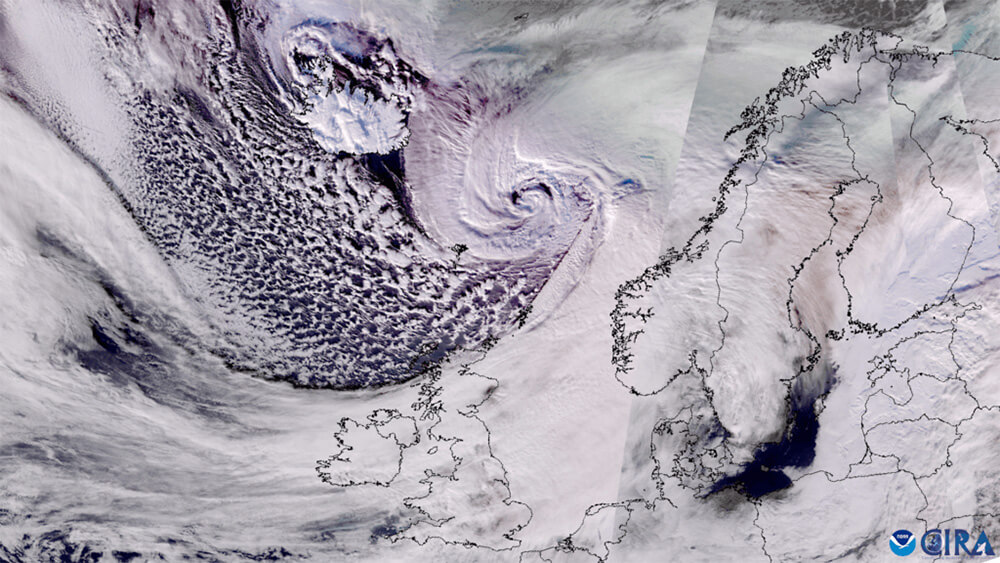Storm Ingunn slammed into Norway’s west coast on Jan. 31, bringing major hurricane-force (Category 4-equivalent) winds, according to the Norwegian Meteorological Institute. The Free University of Berlin named the storm Margrit.
Ingunn is the second storm named by the Northern Group for the 2023-2024 European windstorm season. It is the latest event in an already active season; the Western Group has already named ten storms, the largest number since naming began.
Storm Ingunn caused localized damage to exposed coastal locations in Norway. It was the most severe storm in Norway since the 1992 New Year’s Day Storm, which is known locally as Nyttårsorkanen.
As the storm moved across the North Sea, many Norwegian coastal regions issued red-level weather warnings, including several communities that issued stay-at-home orders due to flying debris. Areas of neighboring Sweden also issued orange-level or amber-level warnings.
Local — But Severe — Wind Damage and Disruption
Storm Ingunn caused widespread disruption to transportation infrastructure across Norway. The northern part of the country was briefly blocked due to severe winds and snow accumulation. Thousands of homes across several counties were without power.
Early reports indicate storm damage in the counties of Vestland, Møre og Romsdal, Trøndelag, and Nordland. In Harstad, Troms County, winds ripped off part of a hospital roof. In Bodø, Nordland County, police sealed the town center to protect the public from flying debris.
The affected Norwegian counties are sparsely populated with few large population centers and limited commercial activity. As a result, insured loss from this event is not expected to be high.
The Norwegian Natural Perils Pool (NNPP), a multinational reinsurance pool instituted in 1980, was enacted to provide natural catastrophe reinsurance coverage to insurers writing in Norway. The NNPP covers natural disaster losses caused by perils including landslides, storms, floods (riverine flooding), storm floods (coastal flooding), earthquakes, and volcanoes. The program is structured to pay out when event-level losses exceed NOK 1.5 billion (EUR 130 million).
For comparison, the 1992 New Year’s Storm was the strongest storm ever recorded in Norway. During that event, stations registered a maximum recorded wind blowing at 45 m/s and gusts near 62 m/s. According to Finans Norge, the storm generated 30,000 claims and insurance payouts neared NOK 2 billion.
About the Storm: A Bomb Cyclone
Ingunn was classified as a “weather bomb,” which occurs when an extratropical cyclone’s central pressure drops by 24 millibars (mb) within 24 hours. Storm Ingunn’s central pressure dropped by over 35 mb in the 24 hours preceding its approach to Scandinavia.
By approximately 9:00 a.m. UTC (10:00 a.m. local time) on Wednesday, Jan. 31, the low reached the Faroe Islands with a central pressure of 960 mb. A weather station on the Landsverk Islands recorded a wind gust of 69 m/s (250 km/h).

Reaching a minimum central pressure of ~944 mb, Ingunn produced incredibly forceful sustained winds and gusts in mainland Norway, making it one of the strongest events to hit the country in 30 years.
According to the Norwegian Meteorological Institute, an observation station at Kvaløyfjellet Sømna recorded a maximum sustained wind of 54.4 m/s with an associated gust of 62.3 m/s. Stations at Nordøyan Lighthouse and Reinsfjellet Gjemnes recorded additional sustained hurricane-strength winds and maximum gusts of 51.5 m/s and 48.9 m/s at each station, respectively.
Severe wind gusts over 30 m/s were recorded in Scotland, Norway, Sweden, Finland, and Latvia.
Satellite imagery suggests that Ingunn’s footprint may have been further enhanced by multiple sting jets, localized areas of very strong gusts. Notably, a sting jet was also contained within the catastrophic event of 87J that occurred in 1987.
This will be the only update on Storm Ingunn from CoreLogic Hazard HQ Command Central™.
Contact: Please email [email protected] with questions about Storm Ingunn or any CoreLogic event response notifications. Visit www.hazardhq.com for updates and information on catastrophes across the globe.
©2024 CoreLogic, Inc. All rights reserved. The CoreLogic content and information in this blog post may not be reproduced or used in any form without express written permission. While all of the content and information in this blog post is believed to be accurate, the content and information is provided “as is” with no guarantee, representation, or warranty, express or implied, of any kind including but not limited to as to the merchantability, non-infringement of intellectual property rights, completeness, accuracy, applicability, or fitness, in connection with the content or information or the products referenced and assumes no responsibility or liability whatsoever for the content or information or the products referenced or any reliance thereon. Hazard HQ Command Central™, CoreLogic®, and the CoreLogic logo are the trademarks of CoreLogic, Inc. or its affiliates or subsidiaries. Other trade names or trademarks referenced are the property of their respective owners.


